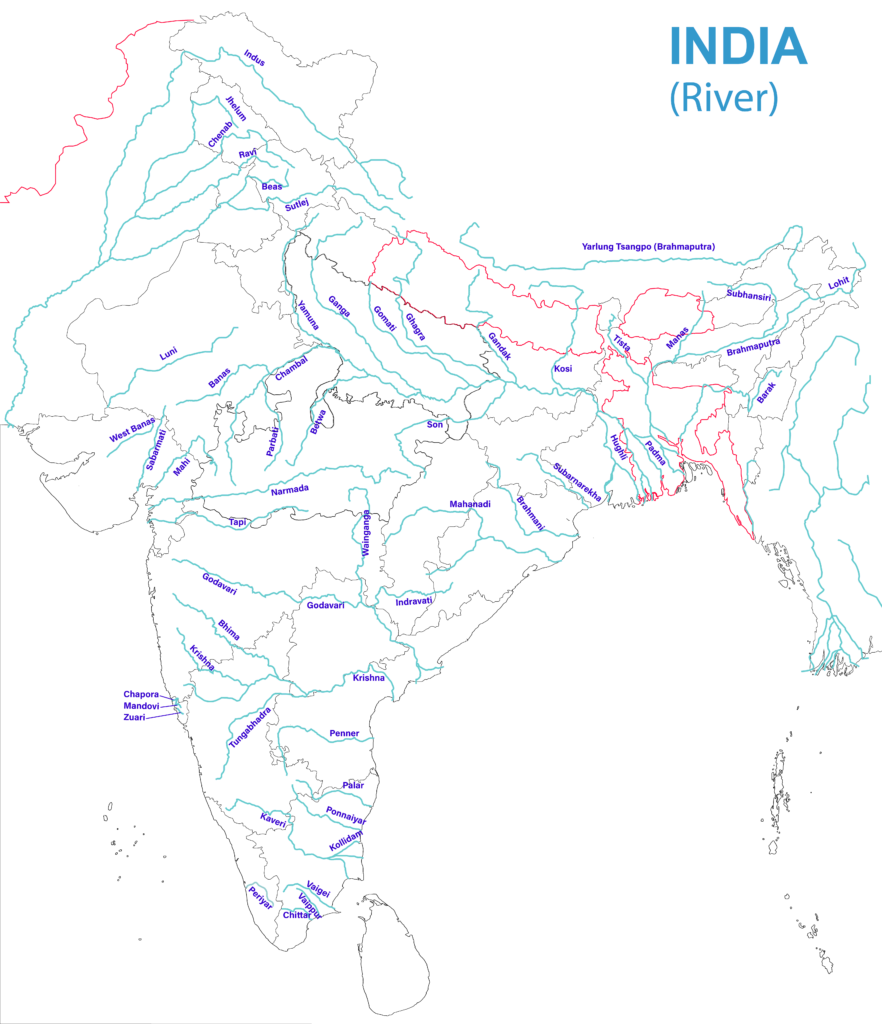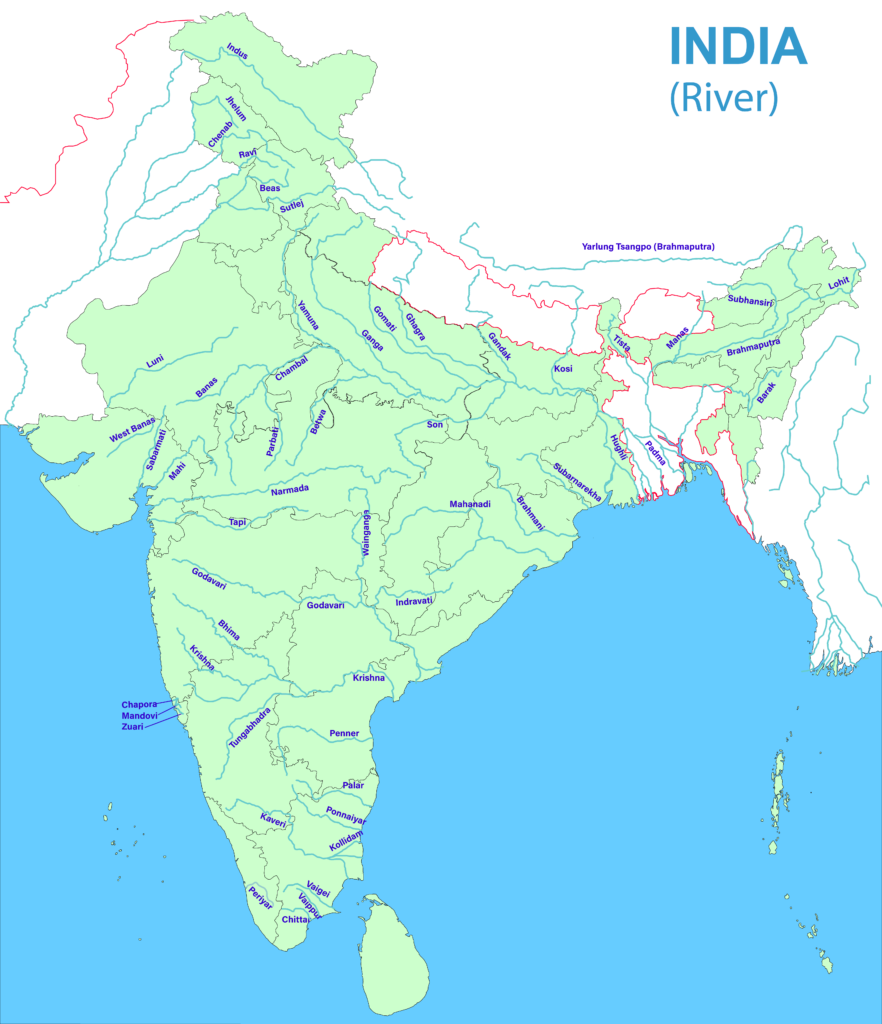Indian River System
Most of the rivers discharge their waters into the Bay of Bengal. Some of the rivers flow through the western part of the country and merges into the Arabian Sea. The northern parts of the Aravalli range, some parts of Ladakh, and arid regions of the Thar Desert have inland drainage. All major rivers of India originate from one of the three main watersheds-
- The Himalaya and the Karakoram range
- The Chota Nagpur plateau and Vindhya and Satpura range
- The Western Ghats

Classification of Drainage Systems of India
Drainage Systems Based on the Size of the Catchment Area
| Division | Size of catchment area in sq km |
| Major river | 20,000 |
| Medium river | 20,000 – 2,000 |
| Minor river | 2,000 and below |
Drainage Systems Based on Origin
- The Himalayan Rivers: Perennial rivers: Indus, the Ganga, the Brahmaputra, and their tributaries.
- The Peninsular Rivers: Non-Perennial rivers: Mahanadi, the Godavari, the Krishna, the Cauvery, the Narmada, and the Tapi and their tributaries.
Drainage Systems Based on the Type of Drainage
The river systems of India can be classified into four groups viz.
- Himalayan rivers, Deccan rivers, and Coastal rivers that drain into the sea.
- Rivers of the inland drainage basin (endorheic basin). Streams like the Sambhar in western Rajasthan are mainly seasonal in character, draining into the inland basins and salt lakes. In the Rann of Kutch, the only river that flows through the salt desert is the Luni.
Drainage Systems Based on Orientation to the sea
- The Bay of Bengal drainage (Rivers that drain into the Bay of Bengal)(East flowing rivers)
- Arabian sea drainage (Rivers that drain into the Arabian sea)(West flowing rivers).
- The rivers Narmada (India’s holiest river) and Tapti flow almost parallel to each other but empty themselves in opposite directions (West flowing). The two rivers make the valley rich in alluvial soil and teak forests cover much of the land.
| The Bay of Bengal drainage | Arabian Sea drainage |
| Rivers that drain into Bay of Bengal | Rivers that drain into Arabian sea |
| East flowing rivers | West flowing rivers |
| ~ 77 per cent of the drainage area of the country is oriented towards the Bay of Bengal | ~ 23 per cent of the drainage area of the country is oriented towards the Arabian sea |
| The Ganga, the Brahmaputra, the Mahanadi, the Godavari, the Krishna, the Cauvery, the Penneru, the Penneiyar, the Vaigai, etc. | The Indus, the Narmada, the Tapi, the Sabarmati, the Mahi and the large number of swift flowing western coast rivers descending from the Sahyadris. |
- The area covered by The Bay of Bengal drainage and Arabian Sea drainage are not proportional to the amount of water that drains through them.
Over 90 per cent of the water drains into the Bay of Bengal; the rest is drained into the Arabian Sea or forms inland drainage.
Contribution of Water by Various Rivers
| River | % Contribution of water |
| Brahmaputra | ~ 40 |
| Ganga | ~ 25 |
| Godavari | ~ 6.4 |
| Mahanadi | ~ 3.5 |
| Krishna | ~ 3.4 |
| Narmada | ~ 2.9 |
| Rest | ~ 20 |
Major River System or Drainage Systems in India
Himalayan River systems
Peninsular River Systems
West Flowing Peninsular River Systems
The Indus River System
The Indus arises from the northern slopes of the Kailash range in Tibet near Lake Manasarovar.
- It has a large number of tributaries in both India and Pakistan and has a total length of about 2897 km from the source to the point near Karachi where it falls into the Arabian Sea out of which approx 700km lies in India.
- It enters the Indian Territory in Jammu and Kashmir by forming a picturesque gorge.
- In the Kashmir region, it joins with many tributaries – the Zaskar, the Shyok, the Nubra and the Hunza.
- It flows between the Ladakh Range and the Zaskar Range at Leh.
- It crosses the Himalayas through a 5181 m deep gorge near Attock, which is lying north of Nanga Parbat.
The major tributaries of the Indus River in India are Jhelum, Ravi, Chenab, Beas, and Sutlej.
The Brahmaputra River System
The Brahmaputra originates from Mansarovar Lake, which is also a source of the Indus and Sutlej.
- It is 3848kms long, a little longer than the Indus River.
- Most of its course lies outside India.
- It flows parallel to the Himalayas in the eastward direction. When it reaches Namcha Barwa, it takes a U-turn around it and enters India in the state of Arunachal Pradesh.
- Here it is known as the Dihang River. In India, it flows through the states of Arunachal Pradesh and Assam and is connected by several tributaries.
- The Brahmaputra has a braided channel throughout most of its length in Assam.
The river is known as the Tsangpo in Tibet. It receives less volume of water and has less silt in the Tibet region. But in India, the river passes through a region of heavy precipitation, and as such, the river carries large amounts of water during rainfall and a significant amount of silt. It is considered one of the largest rivers in India in terms of Volume. It is known for creating the calamity in Assam and Bangladesh.
Ganga River System
- The Ganga originates as the Bhagirathi from the Gangotri glacier.
- Before it reaches Devprayag in the Garhwal Division, the Mandakini, Pindar, the Dhauliganga and the Bishenganga rivers merge into the Alaknanda, and the Bheling drain into the Bhagirathi.
- The Pindar River rises from East Trishul and Nanda Devi unite with the Alaknanda at Karan Prayag. The Mandakini meets at Rudraprayag.
- The water from both Bhagirathi and the Alaknanda flows in the name of the Ganga at Devprayag.
The concept of Panch Prayag
- Vishnuprayag: where the river Alaknanda meets river Dhauli Ganga
- Nandprayag: where river Alaknanda meets river Nandakini
- Karnaprayag: where river Alaknanda meets river Pinder
- Rudraprayag: where river Alaknanda meets river Mandakini
- Devprayag: where river Alaknanda meets river Bhagirathi -GANGA
The principal tributaries of the Ganga are Yamuna, Damodar, Sapta Kosi, Ram Ganga, Gomati, Ghaghara, and Son. The river after traveling a distance of 2525 km from its source meets the Bay of Bengal.
Yamuna River System
- The Yamuna River is the largest tributary of the Ganga River.
- It originates from the Yamunotri glacier, at the Bandarpoonch peak in Uttarakhand.
- The main tributaries joining the river include the Sin, Hindon, Betwa Ken, and Chambal.
- The Tons is the largest tributary of the Yamuna.
- The catchment of the river extends to the states of Delhi, Himachal Pradesh, Uttar Pradesh, Haryana, Rajasthan, and Madhya Pradesh.
The Narmada River System
- The Narmada is a river located in central India.
- It rises to the summit of the Amarkantak Hill in Madhya Pradesh state.
- It outlines the traditional frontier between North India and South India.
- It is one of the major rivers of peninsular India. Only the Narmada, the Tapti, and the Mahi rivers run from east to west.
- The river flows through the states of Madhya Pradesh, Gujarat, and Maharashtra.
- It drains into the Arabian Sea in the Bharuch district of Gujarat.
The Tapi River System
- It is a central Indian river. It is one of the most important rivers of peninsular India with the run from east to west.
- It originates in the Eastern Satpura Range of southern Madhya Pradesh state.
- It flows in a westward direction, draining some important historic places like Madhya Pradesh’s Nimar region, East Vidarbha region and Maharashtra’s Khandesh in the northwest corner of the Deccan Plateau and South Gujarat before draining into the Gulf of Cambay of the Arabian Sea.
- The River Basin of Tapi River lies mostly in eastern and northern districts Maharashtra state.
- The river also covers some districts of Madhya Pradesh and Gujarat as well.
- The principal tributaries of Tapi River are Waghur River, Aner River, Girna River, Purna River, Panzara River and Bori River.
The Godavari River System
- The Godavari River is the second-longest course in India with brownish water.
- The river is often referred to as the Dakshin (South) Ganga or Vriddh (Old) Ganga.
- It is a seasonal river, dried during the summers, and widens during the monsoons.
- This river originates from Trimbakeshwar, near Nasik in Maharashtra.
- It flows east for 1,465 kilometres (910 mi), draining states of Maharashtra (48.6%), Telangana (18.8%), Andhra Pradesh (4.5%), Chhattisgarh (10.9%) and Odisha (5.7%), and drains into the Bay of Bengal.
- The river forms a fertile delta at Rajahmundry.
- The banks of this river have many pilgrimage sites, Nasik(MH), Bhadrachalam(TS), and Trimbak. Some of its tributaries include Pranahita (Combination of Penuganga and Warda), Indravati River, Bindusara, Sabari, and Manjira.
- Asia’s largest rail-cum-road bridge which links Kovvur and Rajahmundry is located on the river Godavari.
The Krishna River System
- Krishna is one of the longest rivers of India, which originates from Mahabaleshwar in Maharashtra.
- It flows through Sangli and drains the sea in the Bay of Bengal.
- The river flows through the states of Maharashtra, Karnataka, Telangana and Andhra Pradesh.
- Tungabhadra River is the main tributary which itself is formed by the Tunga and Bhadra rivers that originate in the Western Ghats.
- Dudhganga Rivers, Koyna, Bhima, Mallaprabha, Dindi, Ghataprabha, Warna, Yerla, and Musi are some of the other tributaries.
The Cauvery River System
- The Cauvery is also known as Ganges of South India “Dakshi Bharat ki Ganga”.
- It originates from Talakaveri located in the Western Ghats.
- It is a famous pilgrimage and tourist place in the Kodagu district of Karnataka.
- The headwaters of the river are in the Western Ghats range of Karnataka state, and from Karnataka through Tamil Nadu.
- The river drains into the Bay of Bengal. The river supports irrigation for agriculture and is considered as a means of support of the ancient kingdoms and modern cities of South India.
- The river has many tributaries called Arkavathy, Shimsha, Hemavati, Kapila, Shimsha, Honnuhole, Amaravati, Lakshmana Kabini, Lokapavani, Bhavani, Noyyal, and Tirtha.
The Mahanadi River System
- The Mahanadi originates from the Satpura Range of central India and it is a river in eastern India.
- It flows east to the Bay of Bengal. The river drains of the state of Maharashtra, Chhattisgarh, Jharkhand, and Orissa.
- The largest dam, the Hirakud Dam is built on the river.


Godavari is known as Dakshin Ganga, not Cauvery!
Ganga of south – Cauvery.
Dakshin Ganga – Godavari.
great article